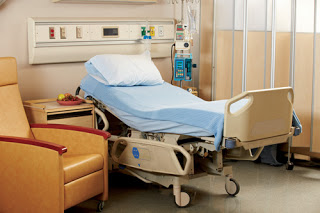Medicare cuts 19 Kentucky hospitals 1% for patient-safety issues; two in Louisville have been been penalized five years straight

Centers for Disease Control and Prevention photo
—–
The federal government is penalizing 19 Kentucky hospitals, nine more than last year, for falling short on patient safety in the fiscal year that ended Sept. 30.
Medicare imposed a 1 percent cut in payment to 800 U.S. hospitals this year that were found to have high numbers of patients with avoidable infections and complications, such as blood clots, urinary-tract and surgical-site infections, bed sores and falls, and infections related to antibiotic-resistant infections, like methicillin-resistant Staphylococcus aureus (MRSA) and Clostridium difficile (C.diff.).
This is the fifth year of the Hospital Acquired Conditions Reduction Program, which was created under the 2010 Patient Protection and Affordable Care Act. The program penalizes the worst 25% of hospitals on a list of patient-safety measures, even if their records have improved from the previous year, Jordan Rau reports for Kaiser Health News.
Critical-access hospitals and specialized hospitals that treat psychiatric patients, veterans and children are exempt from the penalties.
Since the program’s inception, Rau reports, 110 hospitals have been punished all five times. Two of them are in Louisville: the University of Louisville Hospital and Jewish Hospital & St. Mary’s Healthcare.
Ephraim McDowell Regional Medical Center in Danville and Jennie Stuart Medical Center in Hopkinsville are on the penalty list for the fourth straight year.
Norton Hospital / Norton Healthcare Pavilion in Louisville is being penalized for the third straight year, after being penalized the first year of the program but not the second.
Highlands Regional Medical Center in Prestonsburg, Jewish Hospital-Shelbyville, and St. Claire Regional Medical Center in Morehead were penalized last year and are also on the list this year.
Rockcastle Regional Hospital & Respiratory Care Center in Mount Vernon is also on the list for the second year in a row. It has only had one other penalty in the past five years, in 2016.
Owensboro Health Muhlenberg Community Hospital in Greenville is being penalized this year. In the past five years, the only other time it was not penalized was in 2017.
Officials at the Muhlenberg County hospital said the 1% reduction in Medicare reimbursements comes to about $50,000 a year, Renee Beasley Jones reportsfor the Messenger-Inquirer in Owensboro. Beasley reports in depth on the hospital’s penalties and how the administration is working to improve its quality and patient safety scores.
Several hospitals are being penalized for the first time, including: T. J. Samson Community Hospital in Glasgow, Flaget Memorial Hospital in Bardstown, Saint Joseph Mount Sterling, The Medical Center at Albany, Baptist Health Louisville, Lake Cumberland Regional Hospital in Somerset, and Baptist Health La Grange.
Jackson Purchase Medical Center in Mayfield is also being penalized this year. The last time it was on the list was during the first year the penalties were implemented, in 2015.
University of Kentucky Hospital in Lexington has been on the penalty list every other year since the program’s inception, including this year.
Click here for a Kaiser Health News tool that shows Medicare penalties for hospital readmissions and hospital-acquired conditions. The data can be broken down by year, state, hospital, and county.
The hospital industry has long protested these penalties, saying it is the wrong approach to encourage hospitals to improve quality and safety. A 2018 statement from the American Hospital Association cites research that shows only about 41% of the 768 hospitals penalized in 2017 had HAC scores that were significantly higher, statistically speaking, than hospitals not being penalized.
“In other words, the majority of hospitals receiving HAC penalty have performance indistinguishable from those that are not being penalized,” it says.
Further, Rau reports that “hospitals also complain that the ones that do the best job testing for infections and other threats to patients appear to be among the worst based on statistics, while their more lackadaisical peers look better than they might be.”
But supporters of the program argue that “the penalties are warranted in prodding hospitals to improve quality,” he writes.
“The fact that everyone’s talking about it, from front-line nurses to boards of directors, is positioning patient safety where it should be, which is at the forefront of everyone’s minds,” Missy Danforth, the vice-president of health care ratings at the Leapfrog Group, told Rau.
Danforth also dismissed the hospital complaints that the penalties are not fairly applied. She told Rau, “There’s a lot of really strong, good best practices to getting to zero on these infections.”